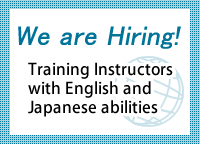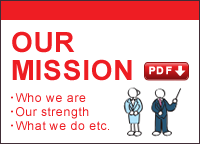 Aims and features
Aims and features
A distinctive feature of the Japanese business culture-Business improvement
A word “Kaizen” has become common even overseas nowadays. You can tell that “business improvement” is one of the most distinctive features of Japanese business culture.
Japanese people always pursue better quality in every aspect such as procedures, process, quality of services and products, productivity, safety, leadership, etc. They never stop pursuing more improvement even though there is no malfunction or inconvenience.
Employees of foreign affiliates or multi-national companies from different cultures might feel unfamiliar with that kind of mindset that focuses on the process as well as the result. However, it is required of all organizations to improve the current business method to enhance the organizational power and increase benefits.
You can still improve business when the number of employees cannot be increased.
The environment surrounding Japanese companies has been drastically changing and increasingly becoming severer due to the diversification and globalization of business world. Many of those firms are required to accomplish works of higher quality to survive. We often hear from our clients that they have to carry out more tasks with the limited personnel without increasing manpower.
Under such a circumstance, we believe that “business improvement” enhances organizational power and efficiency to accomplish the required level of work with the limited number of manpower. Our business improvement training provides you the most effective approaches and skills to enhance organizational power with the limited number of employees.
The following three points are the focuses of this training:
■Think about business improvement in the training, away from your workplace.
It might be often the case that even though you think you would be able to increase efficiency with a little more effort, you actually make no extra effort with no time to spare as an excuse.
Let’s think about “the little more effort” in the training together. The training will help you to make a specific business improvement plan.
■Learn methods of the business improvement
It might be difficult for you to make a business improvement plan when you can think about it only vaguely without any knowledge and skill.
Learn the proper methods of initiating business improvement and practice them on study cases that would happen in the actual workplace.
■Make sure to choose what you can continue practicing
Business improvement plans should vary according to each person. It is highly recommendable to choose a plan that you can start comparatively easily and carry on with low cost such as those regarding communication or clerical work. As for the term, basically about three months are desirable.
Our ultimate goal is that you keep practicing business improvement, motivated by the small improvement you initiated in the training.
We hope our training will provide you with good opportunities to make a greater improvement or to make an improvement on another topic on your own initiative.
How about learning the principle of business improvement in our business improvement training and producing an apparent result?
<Process>
Lecture What is business improvement?
The procedure of business improvement
Exercise Identify problems in your organization from six perspectives.
Lecture, Exercise Analyze the current situation
Lecture Investigate the cause.
Goal-setting
Make countermeasure plans and carry them out.
Check the effect.
Exercise Make a business improvement plan.
 Track Record
Track Record
The reason why our training is popular
As one of training by ranks, we especially have more results in the middle-management class. The purpose of the training varies depending on customers.
For example, there are who aim to improve clerical work by reducing the time of operations or to improve services for customers. Also, there are participants who aim to learn the way of thinking and the awareness to digitize the target as a part of management by objectives for clerical works.
Total participants
3746名(※Period covered:2012/4/1~2013/3/31)
Evaluation
Understood
Comments from participants
- It was useful to learn concretely what to do toward improving operations with a wider viewpoint, not to mention, self-awareness.
- The content would also be useful to my superior. The lecture was easy to understand, realistic, and fun with concrete examples.
- A thorough preparation is required in improving operations. It is important to put thoughts usually in the brain onto papers (schematizing). Hypothesis is important. Many things were very useful. Especially, the law of Pareto was interesting.
- Busy with day-to-day operations, I hardly had time to think. It was useful to learn how to improve.
- I was able to understand how to draw a special cause and effect diagram, and also its importance as well. I am glad to have a chance to appeal improvements.
Our Coach
Instructors, who had practiced a number of business improvements in the field with experiences of successes and failures, will be in charge.
We think that instructors, who have more cases that are concrete and easy to have the image, would be suitable for business improvement. We will introduce instructors with intensive experiences according to ranks of participants and purposes of improvement.
 Sample training program
Sample training program
| Sample Program | ||
|
Lecture | |
|
Lecture | |
|
Lecture | |
|
Lecture | |
|
Group Work | |
この研修カリキュラムはあくまで一例です。お客さまの課題・お悩みに応じて柔軟にカスタマイズ可能です。また、研修効果を高め定着化を促進する「研修呼び覚 まシステム」や研修担当者様の負担を減らし効率向上を支援する「研修管理サービス」もございます。お気軽にご相談下さい。
Contact us
TEL:+813-5577-2273(Tokyo)
 Information
Information- About Us
- Our Mission
- Our Services & Programs
- Milestones
 Our Services & Programs
Our Services & Programs- On-site training & Open Seminars for working people
- Consulting services
- System development and delivery
 Features of Insource training
Features of Insource training- Concepts of Insource training
- Features of Insource training
- Preparation before training
- Evaluating service for the training effects
- Customers' reviews
- Features of Insource's instructors
 Network of Insource
Network of Insource- Tokyo Headquarters
- Hokkaido Branch
- Tohoku Branch
- Kanto Branch
- Osaka Branch
- Nagoya Branch
- Kyushu Branch




